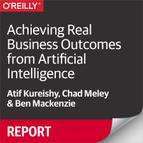Chapter 3. Options and Trade-Offs for Enterprises to Consume Artificial Intelligence
In this chapter, we examine the options available to companies that want to use artificial intelligence (AI) capabilities, which at this time include the following:
-
Purchasing Software as a Service (SaaS) solutions
-
Using public cloud–based APIs
-
Developing custom AI algorithms
SaaS Solutions: Quick but Limited
Perhaps the simplest option for deploying AI within your organization is by taking advantage of SaaS analytics. These are prepackaged, turnkey solutions that are typically in the visual, assistive, or operations space. AI is also being deployed as a feature within existing SaaS offerings such as Customer Relationship Management (CRM) applications.
One example is Everseen, a company that uses deep learning to mine video footage of point-of-sale transactions to detect irregularities. Affectiva operates similarly, deploying advanced video- and audio-mining algorithms to detect emotional patterns. Salesforce Einstein uses AI models to improve on prior-generation models for things like lead prioritization and personalization.
These platforms address real pain points and opportunities and, as such, can certainly create value for organizations, with the broader market for the platform reducing software development costs and driving feature innovation. However, they do have their downsides.
SaaS solutions tend to be a commodity. By design, they have limited configuration and are constricted to the data exposed to the application. Although that makes them easier, cheaper, and less risky to plug in, they also tend to be disconnected from larger business processes.
Enterprises that deploy these solutions don’t need to bother with creating complex algorithms, but this also means that they don’t own any unique IP associated with the algorithm. As a point solution available to a broad market, SaaS solutions do not create competitive advantage.
Cloud AI APIs
With AI APIs in the cloud, developers don’t need to understand AI technology to benefit from powerful deep learning capabilities. These APIs offer easy-to-use services such as computer vision, speech, and language understanding. Training sets for these kinds of algorithms are widely available, and the cloud vendors have the talent and economies of scale to address these common use cases.
All of the leading cloud vendors (e.g., Microsoft, Amazon, and Google) now offer these kinds of API-based services. Like SaaS solutions, deploying cloud APIs requires no hardware installation and minimal or no AI expertise. Their pay-as-you-go pricing model also makes them relatively low risk.
However, they are trained on publicly available data, not on an enterprise’s specific datasets. For instance, a vision API can easily spot a wide range of features in a picture, like wedding dresses, mustaches, celebrities, cats, or swimming pools, but it would be incapable of detecting information that is uniquely valuable to your company, such as hairline cracks in a jet engine component your company produces or operates. So, although cloud AI APIs are valuable in performing common use cases informed by public data, they are not equipped to address insights unique to enterprises such as customer intimacy, operational efficiencies, and risk mitigation.
That said, the reality for large enterprises is that developers will use AI APIs in conjunction with tailored and unique enterprise data and algorithms. For example, a developer could use a voice-recognition API to translate spoken words from a customer care call into text and then combine that outside the cloud API model with other data and analytics unique to their enterprise to achieve improved accuracy in churn models.
Building Custom AI Algorithms
The third option for enterprises to consume AI is creating custom algorithms using frameworks, which would allow organizations more flexibility and agility in utilizing AI. A variety of options are available, including popular open source frameworks like TensorFlow, Keras, and PyTorch, and propriety options like Watson. These frameworks are fairly mature with a high potential for insight.
The development of a custom AI solution allows you to use all of the data within your enterprise and fully integrate it within your processes, tailoring the solution to your unique problems. Talented data scientists have access to many taxonomies, providing opportunities to produce greater predictive outcomes when compared to prebuilt solutions or competitors’ algorithms.
Designing and training deep learning algorithms on enterprise-specific data is the only way companies can create true competitive advantage with AI. It is this type of AI that we will see grow more and more prevalent over the next several years as organizations begin implementing it and seeing its benefits. Its impact can be transformative, allowing you to build new lines of business and radically increase efficiency. In contrast to the other options, however, developing custom AI algorithms requires significant AI expertise, and presents many challenges to deploy or operationalize at scale. Figure 3-1 summarizes the advantages and disadvantages of the three solutions presented in this chapter.

Figure 3-1. Options for enterprise consumption of AI
In Chapter 4, we examine these challenges in detail.
